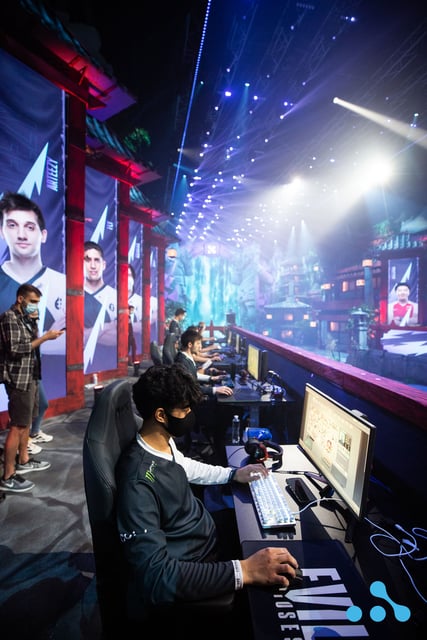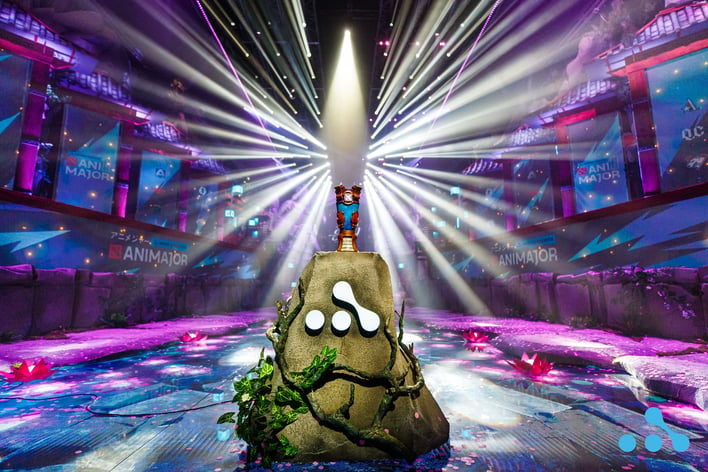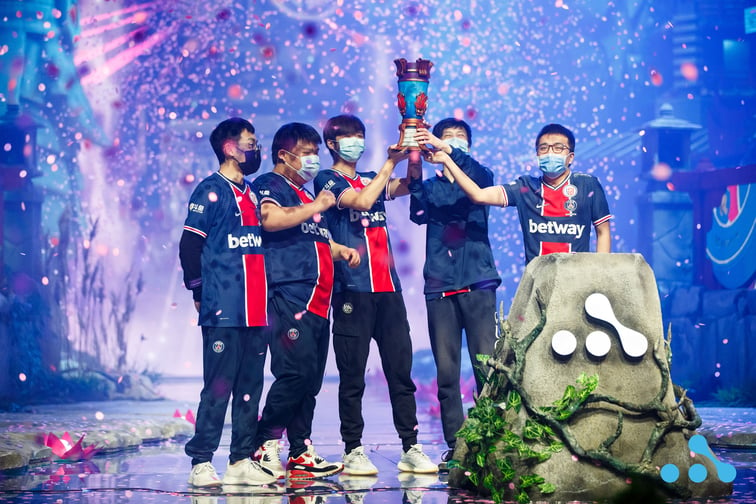Ask any sports fan, and they will tell you there is a unique energy watching a game live and in person. So when the pandemic derailed attendance to the Dota Circuit Pro (DCP) tournament for the second year in a row, show producers WePlay Esports made a bold move to give fans something they would never forget – an anime-themed tournament mixed with augmented reality. The talented team leveraged Pixotope technology to bring Dota 2 heroes to life alongside the pro players that channeled them for the 2021 DCP Major game WePlay AniMajor. The anime theme combined with AR was a first for the world of esports, and according to Forbes, it was one of the greatest events of the Dota 2 scene for 2021.
AniMajor Viewership Statistics:
- Peak Viewers: 645,141
- Hours Watched: 37,325,048
- Average Viewers: 272,944
- Air Time (hours): 137
Pixotope AR Capabilities Create An Immersive Viewer Experience
WePlay’s goal for the fans watching at home was to make them feel like they were at the tournament alongside their favorite teams and esports personalities. To deliver such an experience, they merged the physical and virtual worlds to create immersive canonical virtual environments with characteristics of both Anime and Dota. WePlay used Pixotope to bring the game heroes and environments to life with augmented reality (AR). Pixotope’s AR capabilities also kept audiences visually informed of vital gameplay stats like scores, kills, HP levels, and more.

Putting the Pieces Together
The AniMajor production could only be achieved if all the technology worked perfectly. WePlay used Pixotope to integrate/manage the production cameras, systems, and data sources.
Mechanical and Optical Camera Tracking
Camera tracking was a key tool in creating the immersive feel of AniMajor, ensuring that the physical and virtual environments were correctly aligned. Considering how the camera heads and lenses would impact other special equipment used was critical. Everything needed to move with enough speed for the director's tasks to be successful.
WePlay used a mix of mechanical and optical tracking for Animajor leveraging Pixotope to track the data and replicate it in the virtual environment. Pixotope integrated the cameras into the workflow, managing the key data from both mechanical and optical tracking systems to sync the physical and virtual worlds believably. In this case, that meant adding virtual 3D elements that realistically interacted with the talent to maintain the illusion for viewers at home. The team achieved this quite accurately: ≈ shots were off by less than two-hundredths of a degree equating to a maximum of under two centimeters in the 800m2 studio.
Lighting
A key aspect of achieving a realistic look in AR applications is lighting. The virtual world must have the same lighting and corresponding shadows as the real one. Otherwise, AR objects look jarringly out of place and ruin the illusion.
WePlay used 10 lights for the AR Dota heroes on stage. The lights were connected through Artnet/DMX with midi notes as a trigger within the Pixotope workflow via a 3rd party application designed by their programmers. Virtual lights can be positioned in Pixotope within the virtual environment to match the position, angle, color, and intensity of the physical set-up with the possibility to control the virtual lights through the same DMX interface.

Set Extension/Extended Reality
Beyond AR, WePlay also employed the use of extended reality (XR) - or LED volumes - to help create the illusion of a bigger set for AniMajor. XR technology allowed WePlay to “expand” their real world set in any direction while also masking some real world objects. In effect, it’s a window into an infinite virtual world.
With LED volumes, WePlay expanded the set for viewers at home creating the illusion of vast space. For example, the effect meant that talent could “fly” to a virtual temple where analysts, seemingly located a few kilometers away in the virtual space, would be waiting to provide updated stats and information on the game. Beyond being visually stunning, the application of XR also solved the director's challenge of creating a seamless transition from the commentators' studio to the analytics studio with in-frame editing caused by camera movement.
Creating a New Reality
Pixotope worked closely with WePlay to break new ground in how esports events are produced and experienced. Talk to us about how we can help you push the creative boundaries of your next production and give fans an entirely new experience.


COMMENTS